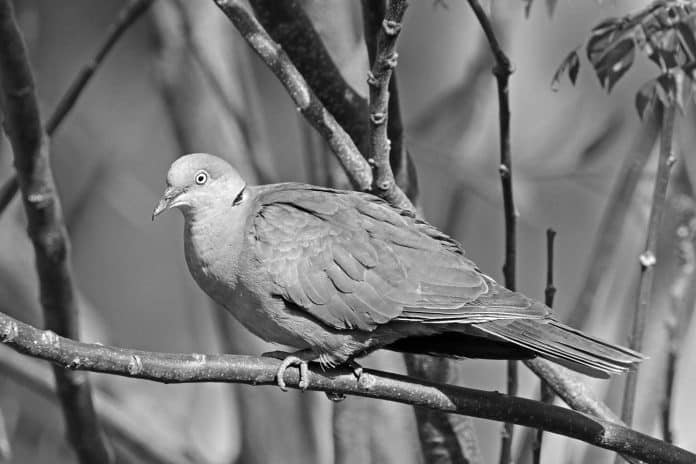In the Heart of Tanzania: A Serenade with the Mourning Collared-Dove – Discover Its Unique Elegance and Haunting Melodies
Introduction to the Mourning Collared-Dove
Welcome to the heart of Tanzania, where nature’s symphony comes alive with the haunting melodies of the Mourning Collared-Dove. This elegant bird, known for its mournful call, is a captivating sight to behold. In this article, we will explore the habitat, physical characteristics, behavior, and conservation efforts surrounding the Mourning Collared-Dove in Tanzania.
Habitat and Distribution of the Mourning Collared-Dove in Tanzania
The Mourning Collared-Dove is a native species to Tanzania, found primarily in the eastern and southern regions of the country. This dove prefers to inhabit savannah woodlands, forest edges, and open grasslands. With its adaptability to different environments, it can also be spotted in urban areas, perched on rooftops or nesting in tree canopies.
The distribution of the Mourning Collared-Dove extends beyond Tanzania, reaching into neighboring countries such as Kenya, Uganda, and Mozambique. However, Tanzania remains its stronghold, providing a diverse range of habitats for this species to thrive.
Physical Characteristics and Unique Features of the Mourning Collared-Dove
The Mourning Collared-Dove is a medium-sized bird, measuring approximately 25 centimeters in length. It has a distinctive appearance, with a grayish-brown body, a black collar on its neck, and a long, tapering tail. Its wings are adorned with white patches, visible during flight.
One of the unique features of the Mourning Collared-Dove is its crimson eyes, which provide a striking contrast against its muted plumage. Additionally, its mournful call, a soft cooing sound that echoes through the trees, sets it apart from other dove species. This haunting melody is often associated with tranquility and has become a familiar sound in the Tanzanian wilderness.
Behavior and Mating Rituals of the Mourning Collared-Dove
Mourning Collared-Doves are highly social birds, forming flocks that can consist of dozens or even hundreds of individuals. These flocks engage in various activities, such as foraging for food and seeking shelter. They are known to feed on a diverse diet, including seeds, grains, fruits, and insects.
During the breeding season, which typically occurs between November and April, the Mourning Collared-Dove engages in intricate mating rituals. The male will display its affection towards the female by bowing, cooing, and puffing its chest feathers. These displays are accompanied by flights in which the male will soar through the air, showcasing its agility and grace.
The Haunting Melodies of the Mourning Collared-Dove
Picture yourself in the Tanzanian wilderness, the sun setting on the horizon, and the gentle breeze carrying the enchanting sounds of the Mourning Collared-Dove. Its mournful call fills the air, creating a captivating atmosphere. The haunting melodies of this bird have inspired poets, writers, and musicians alike, evoking a sense of longing and serenity.
The Mourning Collared-Dove’s call is a soft, rhythmic cooing sound that repeats in a pattern, almost like a lullaby. This melodic tune can be heard throughout the day, but it is most prominent during the early morning and late afternoon. It is believed that these calls serve as a form of communication between individuals, helping them establish their territory and attract mates.
Conservation Efforts and Challenges for the Mourning Collared-Dove in Tanzania
Despite its widespread distribution, the Mourning Collared-Dove faces several conservation challenges in Tanzania. Habitat loss due to deforestation, agricultural expansion, and urbanization poses a significant threat to this species. Additionally, illegal hunting and the capture of wild birds for the pet trade further exacerbate its vulnerability.
To address these challenges, various conservation organizations and government agencies are working together to protect the Mourning Collared-Dove’s habitat and raise awareness about its conservation status. Efforts include establishing protected areas, implementing sustainable land-use practices, and educating local communities about the importance of preserving this iconic bird species.
Best Places to Spot and Observe the Mourning Collared-Dove in Tanzania

If you’re eager to witness the elegance and serenade of the Mourning Collared-Dove, there are several key locations in Tanzania where you are likely to encounter this enchanting bird. The Tarangire National Park, located in the northern part of the country, is known for its diverse birdlife, including the Mourning Collared-Dove. The park’s woodlands and savannahs provide an ideal habitat for this species.
In the southern highlands, the Udzungwa Mountains National Park is another hotspot for Mourning Collared-Dove sightings. This park is renowned for its rich biodiversity and unique avian species, making it a must-visit destination for bird enthusiasts.
Tips for Photographing the Mourning Collared-Dove
Capturing the beauty of the Mourning Collared-Dove through photography requires patience, skill, and an understanding of its behavior. Here are some tips to help you get the perfect shot:
- Use a telephoto lens to capture the intricate details of the dove’s plumage.
- Pay attention to lighting conditions, as soft morning or evening light can enhance the bird’s elegance.
- Approach slowly and quietly to avoid startling the dove.
- Look for interesting compositions, such as the bird perched on a branch or in flight.
- Experiment with different angles and perspectives to create unique and captivating images.
Interesting Facts about the Mourning Collared-Dove
- The Mourning Collared-Dove is known by various names, including the Ring-necked Dove and Cape Turtle Dove.
- It is believed that the mournful call of the Mourning Collared-Dove gave rise to its common name.
- Mourning Collared-Doves are monogamous and form long-term pair bonds.
- These doves are skilled fliers and can reach speeds of up to 55 kilometers per hour.
- Despite their mournful reputation, Mourning Collared-Doves are resilient and adaptable birds.
In the heart of Tanzania, amidst the breathtaking landscapes and diverse wildlife, the Mourning Collared-Dove stands as an emblem of elegance and serenity. Its haunting melodies and unique features make it a truly captivating species to encounter. As we continue to appreciate the beauty of this bird, let us also strive to protect its habitat and ensure its survival for future generations to enjoy. So, embark on a journey to witness the enchantment of the Mourning Collared-Dove and let its serenade echo in your heart forever.
For more articles related to Wildlife in Tanzania (Animals), click here!


































